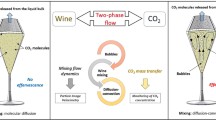Abstract
The simple idea this study rests on is that one cannot be concerned by the bubbling and aromatic exhalation events in champagne tasting without being interested in the study of the flow mixing mechanisms inside the glass. Indeed, a key assumption is that a strong link of causality may exist between inherent liquid-phase flow structures due to bubble motion and the flavors exhalation process. This is the reason why, to underscore the impact of glass-shape and glass-engravement conditions on mixing flow phenomena, classical flow visualization techniques were used to capture fluid motion in traditional flutes and coupes poured with champagne. Laser tomography combined with fluorescent dyes and solid tracers have been used to give the quasi-instantaneous velocity field from which streamline patterns are deduced as well as the vorticity convection.
Similar content being viewed by others
References
Liger Belair, G., 2004, Uncorked, the science of champagne, Princeton University Press, Princeton.
Liger Belair, G., The physics and chemistry behind the bubbling properties of champagne and sparkling wines: a state-of-the-art review, J. Agric. Food Chem. 53, 2005, 2788.
Liger Belair, G., Voisin, C. and Jeandet, P., Modeling nonclassical heterogeneous bubble nucleation from cellulose fibers: application to bubbling in carbonated beverages, J. Phys. Chem B 109, 2005, 14573.
Liger Belair, G., Beaumont, F., Jeandet, P. and G. Polidori, Flow patterns of bubble nucleation sites (called fliers) freely floating in champagne glasses, Langmuir 23, 2007a, 10976.
Liger Belair, G., Religieux, J.-B., Fohanno, S., Vialatte, M.-A., Jeandet, P. and Polidori, G. Visualization of mixing phenomena in champagne glasses under various glass-shape and engravement conditions, J. Agric. Food Chem. 55, 2007b, 882.
Liger Belair, G., Beaumont, F., Vialatte, M.-A., Jegou, S., Jeandet, P. and Polidori, G. Kinetics and stability of mixing flow patterns found in champagne glasses, Analytica Chimica Acta 621, 2008, 30.
Merzkirch W., 1987, Flow visualization, second edition, Academic Press, Orlando.
Polidori, G. and Padet, J., Unsteady flow patterns in the vicinity of heated wall-mounted transverse ribs, Annals of the New York Acad. Sci. 972, 2002, 193.
Polidori, G., Beaumont, F., Jeandet, P. and Liger-Belair G., Artificial bubble nucleation in engraved champagne glasses, Journal of Visualization 11-4, 2008a, 279.
Polidori, G., Beaumont, F., Jeandet, P. and Liger-Belair G., Visualization of swirling flows in champagne glasses, Journal of Visualization 11-3, 2008b, 184.
Polidori, G., Jeandet, P. and Liger-Belair G., Flow Visualization devoted to the science of champagne tasting, 13th Int. Symposium on Flow Visualization, (2008c), paper n0 067.
Author information
Authors and Affiliations
Corresponding author
Additional information
Guillaume Polidori: He received his PhD in Fluid Mechanics in 1994 from the University of Poitiers in France. He became an associate professor in 1994 in the University of Reims in France. He then became a full professor in 2004 in the same University. His main research interests concern theoretical modeling in thermal convection and Flow Visualization applied to various scientific fields such as free convection, underwater swimming in sport science or mixing phenomena in Champagne tasting science. nt]mis
Fabien Beaumont: He has been active in investigating swirling flows from flow visualization techniques since 2000. His other academic interests include free, mixed and forced convection and biomechanical sciences. He works on the development of specific equipments in these research fields.
Philippe Jeandet: He received his PhD and his Doctor of Science title in Plant Physiology and Biochemistry, respectively, in 1991 and 1996 from the University of Burgundy in France. He received an Associate Professor position from the University of Burgundy in 1993 and then moved to the University of Reims as a full Professor. His main research interests concern Physics of bubbles in Champagne, Physico-Chemistry of the foaming properties of Champagne and Sparkling, studies in grape and wine proteins, applications of spectroscopic methods to Enology.
Gérard Liger-Belair: He received his PhD in physical sciences in 2001 from the university of Reims in France. He received an associate professor position at the university of Reims in 2002, and a full professor position, in 2007, in the same university. He has been researching the physics and chemistry behind the bubbling properties of champagne and sparkling wines for several years. His book Uncorked: the science of champagne was published in 2004 by Princeton University Press and won the 2004 award for the Best Professional/Scholarly Book in Physics from the Association of American Publishers.
Rights and permissions
About this article
Cite this article
Polidori, G., Beaumont, F., Jeandet, P. et al. Ring vortex scenario in engraved champagne glasses. J Vis 12, 275–282 (2009). https://doi.org/10.1007/BF03181866
Received:
Revised:
Issue Date:
DOI: https://doi.org/10.1007/BF03181866




